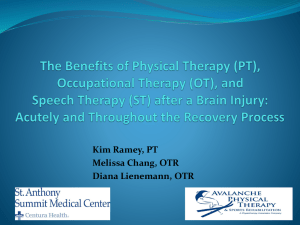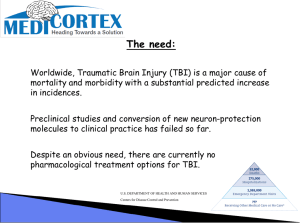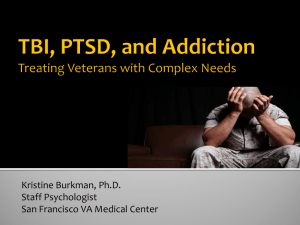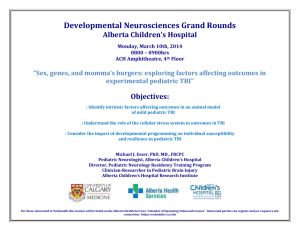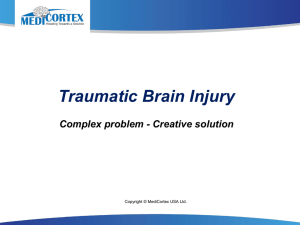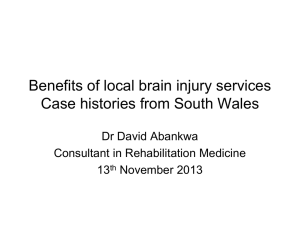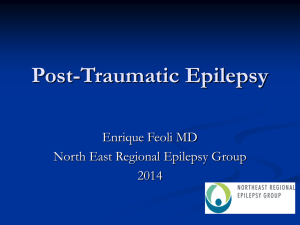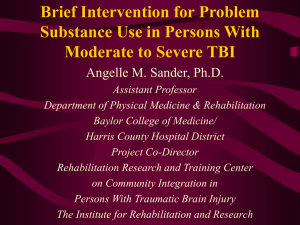post-tbi medical management and secondary medical complications
advertisement
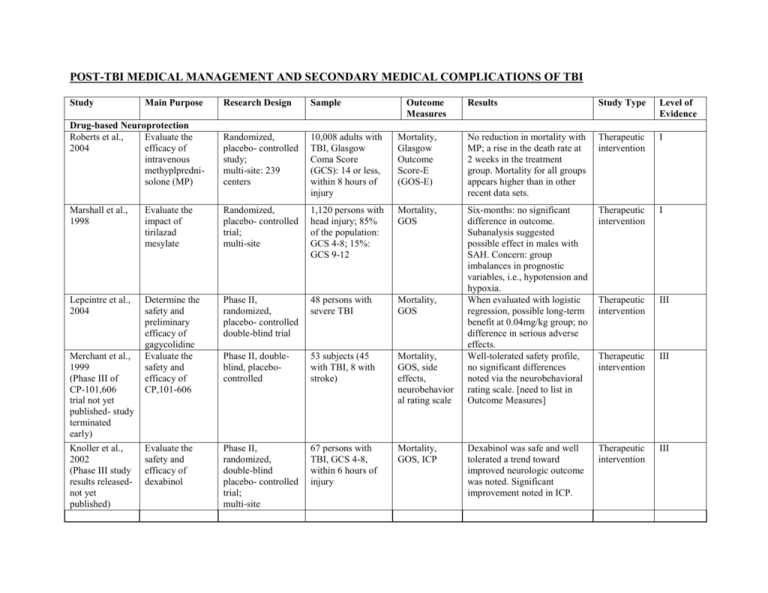
POST-TBI MEDICAL MANAGEMENT AND SECONDARY MEDICAL COMPLICATIONS OF TBI Study Main Purpose Drug-based Neuroprotection Roberts et al., Evaluate the 2004 efficacy of intravenous methyplprednisolone (MP) Research Design Sample Randomized, placebo- controlled study; multi-site: 239 centers 10,008 adults with TBI, Glasgow Coma Score (GCS): 14 or less, within 8 hours of injury Outcome Measures Results Study Type Level of Evidence Mortality, Glasgow Outcome Score-E (GOS-E) No reduction in mortality with MP; a rise in the death rate at 2 weeks in the treatment group. Mortality for all groups appears higher than in other recent data sets. Therapeutic intervention I Six-months: no significant difference in outcome. Subanalysis suggested possible effect in males with SAH. Concern: group imbalances in prognostic variables, i.e., hypotension and hypoxia. When evaluated with logistic regression, possible long-term benefit at 0.04mg/kg group; no difference in serious adverse effects. Well-tolerated safety profile, no significant differences noted via the neurobehavioral rating scale. [need to list in Outcome Measures] Therapeutic intervention I Therapeutic intervention III Therapeutic intervention III Dexabinol was safe and well tolerated a trend toward improved neurologic outcome was noted. Significant improvement noted in ICP. Therapeutic intervention III Marshall et al., 1998 Evaluate the impact of tirilazad mesylate Randomized, placebo- controlled trial; multi-site 1,120 persons with head injury; 85% of the population: GCS 4-8; 15%: GCS 9-12 Mortality, GOS Lepeintre et al., 2004 Determine the safety and preliminary efficacy of gagycolidine Evaluate the safety and efficacy of CP,101-606 Phase II, randomized, placebo- controlled double-blind trial 48 persons with severe TBI Mortality, GOS Phase II, doubleblind, placebocontrolled 53 subjects (45 with TBI, 8 with stroke) Mortality, GOS, side effects, neurobehavior al rating scale Evaluate the safety and efficacy of dexabinol Phase II, randomized, double-blind placebo- controlled trial; multi-site 67 persons with TBI, GCS 4-8, within 6 hours of injury Mortality, GOS, ICP Merchant et al., 1999 (Phase III of CP-101,606 trial not yet published- study terminated early) Knoller et al., 2002 (Phase III study results releasednot yet published) Study Main Purpose Research Design Non-pharmacologic Treatment in the Acute Setting Cooper et al., Evaluate the Prospective, 2004 efficacy of double-blind hypertonic saline randomized, resuscitation controlled trial; multi-site Taylor et al., 1999 Evaluate the role of enhanced nutrition Prospective randomized controlled trial Clifton et al., 2001a Evaluate the role of hypothermia in the treatment of TBI National Acute Brain Injury Study: Hypothermia (NABISH); prospective, randomized controlled trial; multi-site Data from NABISH- I Clifton et al., 2001b Clifton et al., 2002 Reanalyze hypothermia data (see above) Henderson et al., 2003 Evaluate prior studies of hypothermia treatment Meta-analysis McIntyre et al., 2003 Evaluate prior studies of hypothermia treatment Meta-analysis Sample Outcome Measures Results Study Type Level of Evidence 229 persons with TBI and hypotension (systolic blood pressure <100mHg) 82 persons with severe TBI requiring mechanical ventilation GOS-E No significant difference in outcome at 6 months. Therapeutic intervention I GOS, metabolic parameters (energy and nitrogen) Therapeutic intervention III 392 persons with TBI, age 16-65 Mortality, GOS Improved nitrogen balance at 1 week, a trend toward better outcome at 3 months, but similar neurologic outcome at 6 months in the enhanced group. Treatment not effective in improving outcomes. Higher complication rate in the hypothermia group. Wide differences across clinical sites. Therapeutic intervention I 102 persons with TBI (62 from the hypothermia group and 40 from the normothermia group) 748 persons with TBI from 8 randomized controlled trials Mortality, GOS Those hypothermic at admission and <age 45 had significantly better outcomes than those who were normothermic upon admission. Benefit of hypothermia: a potential marginal impact on neurologic outcome. No clear change in mortality. Therapeutic intervention II Metaanalysis NA 12 trials with eligibility criteria Mortality, GOS Hypothermia associated with a 19% reduction in risk of death and 22% reduction in poor outcome. Metaanalysis NA Mortality, GOS, multiple other Palmer et al., 2001 Evaluate the role of the BTF guidelines Randomized trial Fakhry et al., 2004 Evaluate the role of the BTF guidelines Bulger et al., 2002 Evaluate the role of the BTF guidelines Retrospective study comparing data before the guidelines and after Retrospective study to correlate outcome with the guidelines Study Main Purpose Post-TBI Seizure Disorders Schierhout and Determine the Roberts, 2001 value of antiepileptic drug prophylaxis Temkin et al., Evaluate the use 1999 of valproic acid in posttraumatic seizure prophylaxis Watson et al., 2004 Temkin, 2001 Evaluation of glucocorticoids in the development of post-traumatic seizure disorder Determine the value of AED 37 persons prior to the guidelines and 56 after the guidelines 830 persons with TBI who survived more than 48 hours GOS, intracerebral pressure 9.13 odds ratio of a good outcome with the use of the guidelines. Therapeutic intervention III GOS, length of stay A significant decrease in hospital days and charges. Therapeutic intervention III 34 academic medical centers Mortality, GOS Considerable national variation exists in compliance. Aggressive management using the guidelines is associated with decreased mortality. No significant difference in functional status among survivors. Results Therapeutic intervention III Study Type Level of Evidence Prophylactic anticonvulsants are useful in the early, but not the late, prevention of posttraumatic seizures. Valproate shows no benefit over short-term phenytoin therapy for early or late seizures. Trend toward higher mortality in valproate group. Metaanalysis NA Therapeutic intervention I Research Design Sample Outcome Measures Cochrane analysis 10 studies; 2,036 persons with TBI Several Randomized, placebo-controlled study Rate of late posttraumatic seizures, mortality Prospective cohort study People with moderate-severe TBI N=132: 1 week phenytoin N=120: 1 month valproate N=127: 6 months valproate 404 patients with severe TBI Development of posttraumatic seizures Those treated with glucocorticoids within one day of TBI were at higher risk for seizures. Therapeutic intervention III Meta-analysis of antiepileptogenesis and 47 trials evaluating Several For unprovoked seizures, no drug therapy has been shown Metaanalysis NA Annegers et al., 1998 Englander et al., 2003 Angeleri et al., 1999 Diaz-Arrastia et al., 2003 Vespa et al., 1999 Hudak et al., 2004 prophylaxis seizure- prevention trials multiple etiologies, including 12 for TBI 4,541 adults and children with TBI; 1935-1984 to be effective. Identification of risk factors associated with post-traumatic seizures Identification of risk factors associated with post-traumatic seizures Retrospective database review Retrospective database review 647 adults with TBI; 66 developed late post-traumatic seizures Development of seizure activity Determine risk factors for posttraumatic seizures using EEG, neuroimaging Determine if APOE-epsilon4 allele is associated with increased risk of post-traumatic seizures Determine the frequency of convulsive and non-convulsive seizures in the ICU setting Evaluate the ability of video EEG monitoring for the diagnosis of seizures in persons with TBI Prospective 137 individuals with TBI EEG, neuroimaging (CT, MRI) Prospective 106 patients with moderate and severe TBI Prospective Retrospective Development of seizures Severity of injury, subdural hematoma, skull fracture, LOC >1 day, age >65: all associated with increased seizure frequency. Biparietal contusions (66%), dural penetration with bone or metal fragments (62.5%) and multiple intracranial operations (33.4%): associated with increased seizures. An EEG focus 1 month after TBI is a risk factor 3.49 times higher than for patients without such EEG changes. Prognostic III Prognostic III Prognostic II GOS, development of seizure activity Epsilon4 allele associated with increased relative risk (2.41) of late post-traumatic seizures. Prognostic III 94 patients with moderate or severe TBI in the ICU Presence of seizure activity Seizures occurred in 22% of patients; in 52% the seizures were non-convulsive. Descriptive III 127 patients with TBI referred to an epilepsy monitoring unit Presence of seizure activity Monitoring estabilished a diagnosis in 82% of cases: 62% focal seizures, 6% generalized seizures, 33% psychogenic nonepileptic seizures. Diagnostic III Marwitz et al., 2001 Evaluate the incidence and cause of rehospitalization s after TBI Prospective database review 895 patients with TBI, followed 1 and 5 years after injury Rates and causes of rehospitalizati on Shavelle et al., 2001 Evaluate the long-term causes of death after TBI Retrospective database review 2,320 Californians with long-term disability due to TBI Mortality Study Main Purpose Research Design Sample Outcome Measures Case series 20 patients with TBI, 25 elbows; no prior treatment with bisphosphonates or radiation 18 persons with hip HO sustained after brain injury, 21 persons with hip HO after hip injury, and 25 persons with HO and both hip and brain injuries 26 persons with TBI and HO Heterotopic Ossification and TBI Denormandie et Evaluation of al., 1999 outcomes from surgical resection of HO at the elbows Ebinger et al., 2000 Evaluation of outcomes from surgical resection of HO at the hip in persons with and without TBI Case series Johns et al., 1999 Comparison of outcomes of TBI Retrospective, with matched controls The incidence of rehospitalization ranged from 22.9% 1 year after injury to 17.0% at 5 years. At 1 year, one-third of rehospitaliza-tions were for elective reasons. Seizures were a prominent cause of rehospitalization. Mortality was higher between 1 and 5 years postinjury than after 5 years and was strongly related to reduced mobility. Death rates were elevated for circulatory and respiratory diseases, choking/suffocation and seizures, with seizure deaths being relatively frequent, even among the most ambulatory. Results Descriptive III Descriptive III Study type Level of Evidence ROM, mobility on follow-up examination 58% cases classified as having a good outcome, with >70% gain in mobility, 42% with gain of 40-70% mobility. Therapeutic intervention IV Radiographs, ROM Those with hip injury alone did best functionally on 1- and 5-year follow-up; no difference seen in reoccurrence of HO. Those with more severe TBI had more significant HO. Therapeutic intervention IV Functional Independence Patients with HO had lower functional FIM scores upon Correlationa l III rehabilitation inpatients with and without HO Study Main Purpose Deep Vein Thrombosis and TBI Agnelli et al., Efficacy of 1998 enoxaparin and compression stockings in the prevention of DVT in neurosurgical patients Raabe et al., Determine safety 2001 of heparin for DVT prophylaxis in neurosurgical patients matched with 26 persons with TBI and no HO, all admitted to acute inpatient rehabilitation Sample Measure (FIM) scores, discharge disposition Randomized, doubleblind, placebocontrolled trial 307 acute inpatients total (154 treatment and 153 placebo) Retrospective case series 1,564 patients total, 1,197 receiving major neurosurgery, 367 with shunting or extraventricular drain placement (minor procedure) 950 acute inpatients who underwent neurosurgery, 152 of whom underwent cranial surgery 100 patients admitted to an acute hospital for craniotomy Research Design Wen and Hall, 1998 Evaluate early administration of heparin for DVT prophylaxis in neurosurgical patients Case series Macdonald et al., 2003 Comparison of unfractionated heparin and dalteparin for DVT prophylaxis in Randomized prospective study admission and discharge. No differences noted on cognitive FIM scores. Patients with HO also had lower FIM efficiency and were more likely to be discharged to a facility. Results Prognostic Study Type Level of Evidence Presence of DVT or hemorrhage 32% placebo versus 22% in treatment group with DVT; 13% versus 5% for proximal DVT; no difference in major bleeding. Therapeutic intervention I Hemorrhage Hemorrhage rate of heparinized patients was 1.8%: all in major-surgery group. Therapeutic intervention III Hemorrhagic events 2 minor hemorrhagic events (both in cranial cases) and 3 major bleeding complications (2 in laminectomy cases, 1 in a cranial case) were noted. Therapeutic intervention III Hemorrhage, pulmonary embolism or DVT No significant difference in hemorrhage, thromboembolic events or thrombocytopenia in either group. Therapeutic intervention III Outcome Measures Iorio and Agnelli, 2000 Kim et al., 2002 Norwood et al., 2002 Yablon et al., 2004 Akman, et al., 2004 persons receiving craniotomy Determine the safety and efficacy of heparinoids in prevention of DVT in neurosurgical patients Evaluate the safety and efficacy of the early use of heparin for DVT prophylaxis in persons with intracranial hemorrhage Evaluation of safety and efficacy of enoxaparin for DVT prophylaxis in persons with blunt head trauma Determination of prevalence and risk factors for DVT in rehabilitation inpatients Evaluation of the D-dimer test as a Meta-analysis of clinical trials 1,022 acute patients for safety analysis, 827 for efficacy analysis Development of DVT, PE or hemorrhage Rate of 22.6% thromboembolic events; heparin prophylaxis resulted in 45% relative risk reduction. Number needed to treat to prevent VTE was 7.7, 16 for prevention of proximal DVT. Number needed to harm was 102 for heparin and 115 for LMWH (low molecular weight heparin). No increase in bleeding was seen in the group treated early with heparin. No difference was seen in VTE between the two groups. Metaanalysis NA Retrospective case series 64 acutely hospitalized patients with intracranial hemorrhage Development of DVT, PE or hemorrhage Therapeutic intervention III Prospective case series 150 acute head trauma inpatients Progression of ICH (intracranial hemorrhage), development of DVT 23% had progression of ICH on follow-up CT scans, 19% prior to initiation of enoxaparin,4% after. All patients who had further ICH after treatment survived. DVT found in 2%. Therapeutic intervention III Prospective case series 709 consecutive rehabilitation admissions with brain injury (TBI=360) Presence of DVT DVT prevalence of 11.1%; 6.7% in the TBI subgroup. Positive D-dimer assay highly correlated with DVT (p=0.001). Descriptive Correlationa l III Prospective case series 68 consecutive rehabilitation Presence of DVT D-dimer had sensitivity of 95.2%, but specificity of only Screening III screening tool for DVT Meythaler et al., 2003 Comparison of two methods of D-dimer assays in predicting DVT Prospective case series Wagner et al., 1999 Evaluation of the effect of DVT on rehabilitation outcome in TBI patients Consecutive case series with casematched controls Study Main Purpose Research Design Post-TBI Spasticity Meythaler et al., Evaluation of 2001 tizanidine in the treatment of spasticity of CNS origin Meythaler et al., Evaluation of 2004 baclofen in the treatment for spasticity due to brain injury Meythaler et al., Evaluation of 1999a intrathecal baclofen in the treatment of spasticity of CNS origin Meythaler et al., Evaluation of 1999b intrathecal baclofen in the Randomized, doubleblind, placebocontrolled crossover trial facility admissions (TBI =4) 35 persons admitted to an acute facility with TBI 55.3%. Presence of DVT Screening III Prognostic III 46 TBI patients with lower extremity (LE) DVT at rehabilitation admission and 46 matched controls with TBI and no DVT Sample Discharge disposition, FIM scores, rehabilitation LOS, presence of DVT Outcome Measures Results Study Type Level of Evidence 17 patients total, 9 with stroke, 8 with TBI, >6 months of spasticity 35 patients total, 22 with TBI, all at least 6 months post injury Significant decrease in LE Ashworth, LE spasm and upper extremity (UE) Ashworth scores. Increase in motor strength. In TBI patients, decrease in LE Ashworth scores and reflex scores; no change in UE spasticity measures. 17% incidence of somnolence. Decrease in LE Ashworth, spasm and reflex scores; no decrease in motor strength of the unaffected side. Therapeutic intervention III Therapeutic intervention IV Therapeutic intervention III Decrease in baseline Ashworth, spasm and reflex scores in UE and LE. Therapeutic intervention IV Randomized, doubleblind, placebocontrolled crossover trial 6 persons with hemiplegia and spasticity due to stroke (n=3) or TBI (n=3) Ashworth and spasm scores, muscle strength, side effects Ashworth and spasm scores, tendon reflexes, motor strength Ashworth and spasm scores, deep tendon reflexes, motor strength Case series 17 patients with TBI and spasticity Ashworth, spasm and reflex scores Uncontrolled trial Latex agglutination assay and ELIZA correlated well with each other, but remained significantly elevated throughout the trial. No patients developed VTE. No significant difference in LOS, rehabilitation costs or FIM scores. Persons with DVT were more likely to be discharged home. Rawicki, 1999 Francois et al., 2001 Dario et al., 2002 Pavesi et al., 1998 Francisco et al., 2002 Singer et al., 2004 treatment of TBI-related spasticity Evaluation of the use of intrathecal baclofen as longterm management of spasticity of cerebral origin Evaluation of the use of intrathecal baclofen to treat autonomic instability and tone in acute severe TBI Evaluation of intrathecal baclofen with thoracic level catheter placement in anoxic brain injury Evaluation of botulinum toxin (BT) in the treatment of UE tone in TBI Evaluation of botulinum toxin in two different dilutions for UE spasticity Determine incidence of ankle contracture in acute inpatient TBI Case series 18 patients with spasticity of cerebral origin Functional status, evaluation of tone 17/18 patients with significant reduction in tone, increased function and/or decreased nursing care needs. Therapeutic intervention IV Case series 4 persons with severe TBI and autonomic instability Medical outcome, Ashworth scores, blood pressure, pulse 1 patient died of urosepsis; all remaining patients showed improvement in Ashworth scores and decrease in autonomic instability. Therapeutic intervention IV Case series 14 patients with TBI or anoxic injury with significant spasticity Spasm scores, Ashworth score Improvements noted in Ashworth scores and spasm frequency scores. Therapeutic intervention IV Case series 6 patients with TBI and UE spasticity Evaluation of arm function, Ashworth scores Improvements noted in Ashworth score and arm function. Therapeutic intervention IV Randomized controlled trial 13 patients total, 10 with spasticity due to stroke and 3 due to TBI 105 admissions to inpatient rehabilitation with diagnosis of moderate or Ashworth scores Decreased spasticity in both groups; no difference in efficacy due to dilution of botulinum toxin. Therapeutic intervention III Muscle tone, range of motion, mobility status Spastic tone was noted in 13.3% of patients, dystonic tone in 21.9%. Dystonic tone significantly associated with development of ankle Descriptive Prognostic IV Case series rehabilitation Study Main Purpose Post-TBI Dysautonomia Baguley et al., Describe the 2004 clinical treatment and complications of those with dysautonomia Becker et al., 2000 Cuny et al., 2001 Baguley et al., 1999 Study Demonstrate a role for intrathecal baclofen in the treatment of severe dysautonomia Describe use of intrathecal baclofen for severe dysautonomia Evaluate the impact of dysautonomia on outcome Main Purpose Post-TBI Hydrocephalus Phuenpathom et Determine rates al., 1999 and risk factors for the development of post-traumatic hydrocephalus severe TBI Research Design Sample Outcome Measures Controlled case series 35 cases of persons with dysautonomia, 35 controls Documentatio n of clinical treatments and symptom complexes Case series 4 persons with brain insults (2 SAH, 1 TBI, 1 ICH) Severe dysautonomic symptoms Case series 4 persons with acute TBI and dysautonomia Controlled case series Research Design Retrospective chart review contractures. Weak association between severity of injury and development of ankle contractures. Results Study Type Level of Evidence Dysautonomic patients more likely to receive medications with CNS action; midazolam and morphine often used to control heart and respiratory rate; chlorpromazine used for respiratory rate. 3 of 4 patients’ autonomic symptoms successfully treated with intrathecal baclofen. Correlationa l IV Therapeutic intervention IV Clinical symptoms of dysautonomia All cases improved by day 6 of trial. Therapeutic intervention IV 35 persons with TBI, noted to have dysautonomia Sample GOS, post traumatic amnesia (PTA), LOS Outcome Measures Dysautonomic group had longer rehabilitation LOS, longer PTA, lower GOS scores. Results Prognostic IV Study Type Level of Evidence 1,008 patients seen at acute care hospitals after brain injury Development of hydrocephalus 17 patients with hydrocephalus (1.6% of sample); high correlation with those who had received decompressive craniotomy. Descriptive Prognostic IV Mazzini et al., 2003 Determine rates and outcomes from posttraumatic hydrocephalus Retrospective chart review 140 patients with severe TBI admitted to inpatient rehabilitation Development of hydrocephalus and post-injury epilepsy, GOS, Disability Rating Scale (DRS), FIM Tribl and Oder, 2000 Determine outcomes from ventriculoperitoneal shunt placement for post-traumatic hydrocephalus Observational 48 patients with severe TBI who had undergone VP shunt placement for hydrocephalus Development of post-shunt seizures and other complications/ outcomes Study Main Purpose Research Design Sample Outcome Measures Determine the value of S-100B as a biomarker of TBI Meta-analysis 18 clinical trials Evaluate the role of S-100B in predicting outcome in mild TBI Evaluate the role of S-100B in predicting outcome Evaluate the role of S-100B in predicting outcome 6 months post Observational TBI Prognosis Raabe et al., 2003 Stranjalis et al., 2004 Townend et al., 2002 Raabe and Seifert, 2000 Hydrocephalus found in 45% of patients, severe in 11%. Presence of hydrocephalus correlated with age, duration of coma and decompressive craniotomy; correlated at 1 year with GOS, DRS, FIM and development of post-traumatic epilepsy. An average 3.3 years post surgery, 52.1% benefited from shunt implantation. Posttraumatic seizures seen in 31 patients. Shunt revision required in 15 patients. Best predictor of good outcome was higher GOS prior to surgery. Results Descriptive Prognostic IV Therapeutic intervention IV Study Type Level of Evidence Brain damage Extracranial release present, but impact limited; S-100B is a serum biomarker of brain damage. Metaanalysis NA 100 subjects with mild TBI Return to work Elevated S-100B correlated with decreased rate of return to work by one week. Prognostic II Observational study 148 adults with TBI within 6 hours of injury GOS-E A significant inverse correlation between serum S100B and GOS-E. Prognostic II Observational study 25 persons with TBI evaluated at 6 hours and serial lab –S100B for up to GOS at 6 months For patients with unfavorable outcome, S-100B markedly increased, and a second peak was noted at 6 days. Prognostic III study Chatfield et al., 2002 Lima et al., 2004 Vos et al., 2004 Wagner et al., 2004 Chiang et al., 2003 Crawford et al., 2002 Lichtman et al., 2000 Groswasser et Evaluate the role of c-tau and S100B in predicting outcome post TBI Evaluate the role of NSE in predicting outcome Observational study Observational study Evaluate the role of biomarkers in predicting outcome Evaluate cerebrospinal fluid (CSF) biomarkers and the contribution of gender Determine the role of APOE polymorphism in the outcome of persons with TBI Determine the role of APOE polymorphism on memory of persons with TBI Determine the role of APOE polymorphism in rehabilitation outcome Determine the 10 days 20 persons with TBI GOS S-100B, but not c-tau, correlated with poor outcome. Prognostic III 4 groups of mixed neurologic dysfunction; 51 subjects GOS Prognostic III Observational study 85 persons with severe TBI GOS at 6 months Serum NSE may not be sensitive to fine neuronal or clincial outcome changes ,but patients with lower GOS scores had higher NSE levels than those with lower GOS scores. S100b, GFAP and NSE all predicted poor outcome. Prognostic III Prospective evaluation of CSF parameters 68 persons with severe TBI Measures of oxidative stress Females evidenced smaller oxidative stress load. Response to stress declines with age. Correlationa l II Observational study 100 persons with severe TBI GOS Significant association between APOE allele and sixmonth outcome. Prognostic II Observational study 110 persons with TBI in the Defense and Veterans Head Injury Program 31 persons with TBI who completed a neurorehabilitati on program 74 persons with Measures of executive function and memory Significant correlation of APOE allele and memory dysfunction. Prognostic II APOE polymorphism, FIM Presence of APOE4 allele adversely affects rehabilitation outcome. Prognostic III Return to Third ventricle ratio on late Prognostic III Observational study Retrospective al., 2002 Englander et al., 2003 Gerber et al., 2004 Scheid et al., 2003 Hattori et al., 2003 Bergsneider et al., 2001 Bergsneider et al., 2000 Ricker et al., 2001 ability of CT ventricle ratios to evaluate longterm outcome Evaluate the ability of CT to predict functional outcome at rehabilitation discharge Evaluate the role of MRI in detecting lesions after TBI Evaluate the role of MRI in detecting lesions after TBI Evaluate the role of PET in detecting dysfunction after TBI Evaluate the relationship between PET and functional status Evaluate the relationship between PET and level of awareness Compare PET changes in verbal recall between those with and without TBI analysis of CT data penetrating TBI and 34 with closed TBI work, measures of cognitive functioning DRS, FIM Prospective longitudinal design 1,839 persons within the TBI Model Systems Comparative analysis of MRI data 43 persons with TBI Presence of lesions Prospective MRI imaging 66 persons with TBI Presence of lesions Comparison group study 23 persons with TBI and 11 healthy volunteers Level of activation in brain regions Observational study 13 persons with TBI studied via PET DRS Observational study 42 persons with severe TBI Comparison group study 5 persons with severe TBI and 4 healthy controls CT scan is a powerful predictor of cognitive outcome and return to work. Midline shift of greater than 5mm associated with supervision needs. Those with subcortical contusions were more likely to require assist in ambulation and lower body dressing. T2 gradient echo more sensitive for detecting hemorrhagic lesions and related to PTA. T2 gradient echo superior at the detection of DAI. Prognostic II Screening Correlationa l II Screening III Differences in subcortical and cerebellar activation among those with greater level of arousal as compared to those functioning at lower levels. Quantative FDG-PET correlated with level of global functional recovery (DRS). Correlationa l IV Prognostic IV Level of consciousness Dissociation was found between cerebral glucose metabolism and level of consciousness. Correlationa l III Changes in PET activation TBI group lacked change in cerebellar region during free recall. Correlationa l III Ptak et al., 2003 Huisman et al., 2004 Garnett et al., 2000 Friedman et al., 1999 Uzan et al., 2003 Evaluate the relationship of MRI cerebral fractional anisotropy (CFAST) in detecting white matter Evaluate the relationship of MRI detecting white matter change via diffusion tensor imaging (MRIDTI) and severity parameters Evaluate the ability of magnetic resonance spectroscopy (MRS) to predict outcome Evaluate the ability of MRS to predict outcome Observational study 30 persons from ED and 15 from trauma service [CFAST Hospital LOS, mortality, intensive care unit (ICU) LOS Rehabilitation discharge Rankin score CFAST correlates with outcome measures. Prognostic III Comparison study of imaging and outcomes 20 persons with TBI MRI- DTI correlated with acute GCS and Rankin score. Prognostic III Observational study 19 persons with TBI GOS DRS NAA/CHO and CHO/CR correlate with outcome. Prognostic III Observational study 14 persons with TBI studied soon after injury and again at 6 months 14 persons with severe TBI in vegetative state Neuropsycholo g-ical performance, GOS NAA predicted neuropsychological performance and GOS. Prognostic III Evaluate the ability of MRS to predict those likely to remain in vegetative state Observational study Measures of arousal NAA/CR ratio was lower in those who remained in vegetative state. Prognostic IV Sleigh et al., 1999 Evaluate the ability of SSEP to predict outcome Observational study 105 persons with severe TBI, GCS 6 or less GOS Bilateral absence associated with poor outcome. Bilaterally normal: 51% chance of good outcome. Prognostic III Lew et al., 1999 Evaluate the potential of P300 to predict outcome Evaluate the potential of P300 to predict outcome Observational study 22 healthy adults and 6 persons with TBI Mortality Correlationa l IV Comparison study III Correlational study of prospective cohort P300 responses, auditory and visual reaction time tests GOS DRS Correlationa l Evaluate the ability of longlatency responses to predict outcome Evaluate the relationship between MRI findings and P50 potential Compare P50 in controls and those with TBI Evaluate physiological factors that may be associated with poor outcome from TBI Determine the power of early acute scores to predict discharge disposition 11 persons with TBI (with favorable recovery) and 11 controls 21 persons with severe TBI and 11 volunteers Prognostic III Observational study 10 persons with TBI and 10 controls P50 response 2 persons with no response died; those with less severe injuries evidenced a larger response. Diminished amplitude and prolonged latency P300 were seen in those with TBI. Reaction time tests also prolonged. Those with lower GOS scores at 1 year had significantly longer latency and lower amplitude long-latency responses. Hippocampal injury was related to P50 non-supression post TBI. Correlationa l III Comparison study 20 persons with TBI and 20 controls 81 patients with blunt TBI in an acute care hospital P50 response P50 was significantly greater in those with TBI. Correlationa l III Mortality, hospital LOS Hypotension, hyperglycemia and hypothermia associated with increased mortality. Metabolic acidosis and hypoxia were associated with longer hospital stays. Correlationa l IV 378 patients with TBI admitted to a level 1 trauma hospital Discharge disposition Revised Trauma Score and Injury Severity Score predicted discharge to home or to inpatient rehabilition. Prognostic IV Lew et al., 2004 Mazzini et al., 2001 Arciniegas et al., 2001 Arcinegas et al., 2000 Jeremitsky et al., 2003 Wagner et al., 2000 Observational study Observational study Duong et al., 2004 Determine the impact of strength, balance and swallowing deficits on outcomes Observational study 2,363 persons with TBI in inpatient rehabilitation FIM scores, need for assistance after discharge Greenwald et al., 2001 Determine relationship of severity measures to sitting and standing balance Main Purpose Observational study 908 patients with TBI in acute inpatient rehabilitation None Research Design Sample Retrospective review of database Database of 18 brain injury units in France, 876 person with TBI Study Rehabilitation Interventions Mazaux et al., Evaluate the 2001 impact of early rehabilitation interventions on outcome Leg strength less than 3/5 on admission to rehabilitation, swallowing disorders, and decreased balance were associated with increased need for assistance after rehabilitation discharge and at 1 year. Balance skills on admission were correlated with age, injury severity and acute care complications. Prognostic IV Correlationa l IV Outcome Measures Results Study Type Level of Evidence Improved outcome and lower cost with early intervention. Therapeutic intervention IV Stimulation early in care may help therapy. Stimulation resulted in changes in heart rate and respiration. The absence of any response to early stimulation carries a potential unfavorable prognosis. Early rehabilitation consults (<48 hours) resulted in decreased LOS and improved FIM scores at discharge from acute care. Age predicted intensity of services; therapy intensity was Therapeutic intervention IV Therapeutic intervention III Correlationa l Prognostic III Lippert-Gruner et al., 2002 Evaluate the role of early stimulation (multi-modal, early onset stimulation) in TBI Case series 16 persons with severe TBI and coma of at least 48 hours Medical complications, GOS, European Head Injury Evaluation Chart ADL Behavioral and sensorimotor exam Wagner et al., 2003 Determine the value of early rehabilitation intervention in a trauma system Identify factors relating to intensity of Retrospective analysis 1,866 persons with non-fatal TBI LOS, FIM at acute care discharge Multi-center, prospective nonrandomized study 491 persons with TBI in inpatient rehabilitation Services provided, FIM, LOS Cifu et al., 2003 Zhu et al., 2001 Cannning et al., 2003 Page and Levine, 2003 Karman et al., 2003 Wilson et al., 2002 Mossberg et al., 2002 rehabilitation services Determine the role of therapy intensity on outcome Determine the role of an intensive sit-tostand program on motor performance Determine the efficacy of a modified constraintinduced therapy program Randomized controlled, assessorblind trial 36 persons with TBI FIM and GOS Single-blind, randomized controlled pilot study 24 subjects with severe TBI (experimental treatment group 13; standard group 11) 3 subjects with TBI and upper limb hemiparesis, at least one year post injury Measures of exercise capacity Multiple base line, pre-post case series Evaluate the feasibility and efficacy of constraintinduced movement therapy in acquired brain injury Document recovery pattern of persons using partial weightbearing support Multiple case series 7 children with acquired brain injury and hemiparesis Case series 2 patients with TBI (one less than 6 months post injury and one more than 2 years post injury) Assess cardiorespiratory response of treadmill Repeated-measures, pre-post design 40 subjects with TBI predictive of motor function at discharge. Trend toward improved FIM and GOS at 3 and 6 months in those receiving more intense services. 62% improvement in motor performance, compared with 18% for the control group. Therapeutic intervention III Therapeutic intervention IV Action Research Arm Test, Wolf Motor Function, Motor Activity Log Actual Amount of Use Test, Quality of Movement Scale Subjects displayed improved task performance and motor function. Therapeutic intervention IV Improved quality of limb use and actual amount of use. Therapeutic intervention IV Missouri Assisted Gait Scale (MAGS), standing balance, muscle strength Aerobic capacity, movement efficiency Improvement in MAGS was found. Therapeutic intervention IV Improved aerobic capacity and movement efficiency was found. Therapeutic intervention III Study ambulation after ABI Main Purpose Pharmacology and Depression Perino et al., Evaluate 2001 citalopram and carbamazepine in the treatment of post-TBI major depression Research Design Sample Outcome Measures Results Study Type Level of Evidence Prospective open label 20 persons with TBI and psychiatric or behavioral disturbance Brief Psychiatric Rating Scale (BPRS) and Clinical Global Impression scale (CGI) Results suggest efficacy for citalopram and carbamazpine. Therapeutic intervention III

